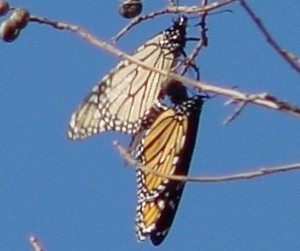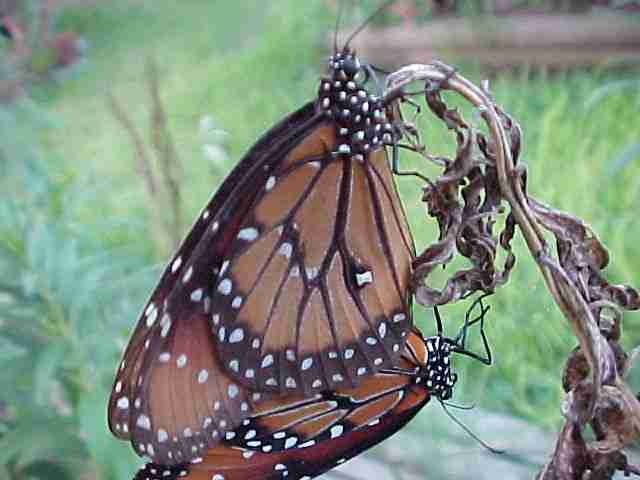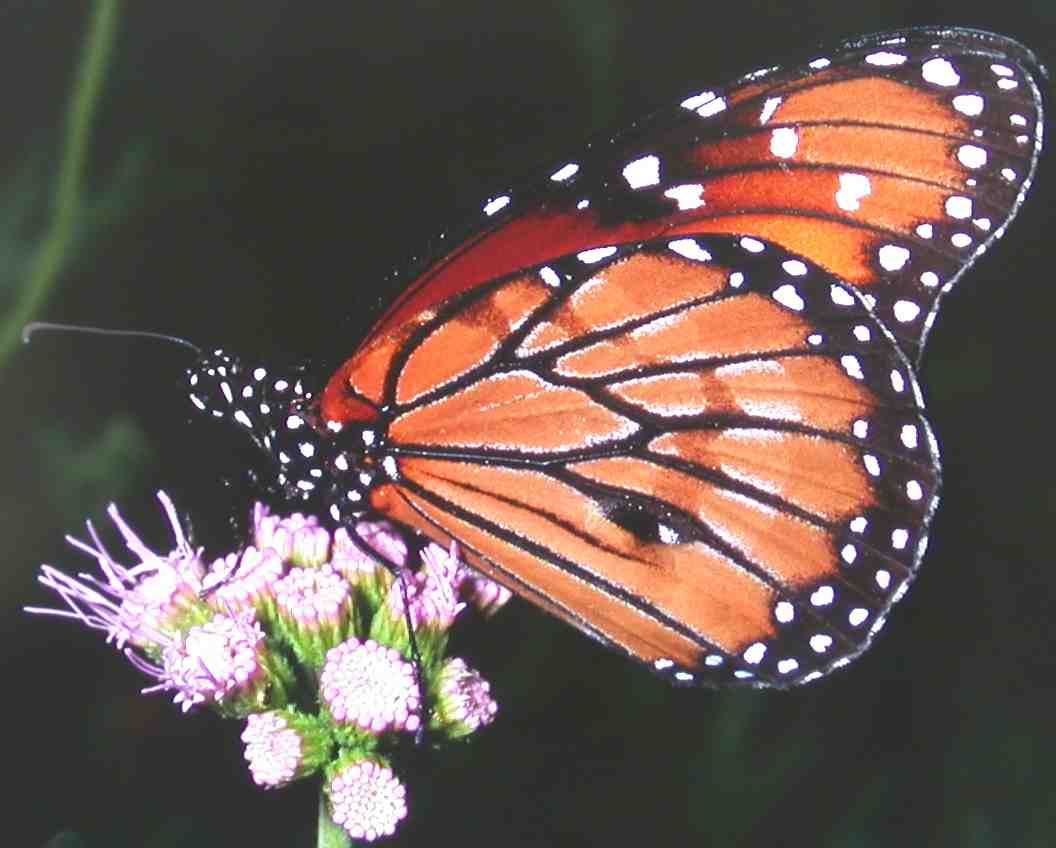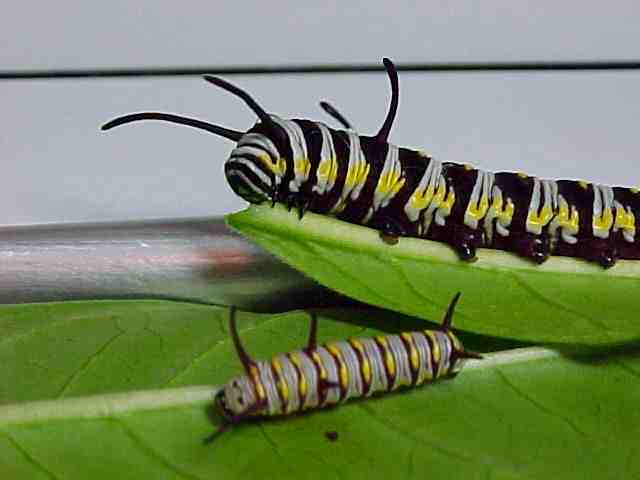We had heard of Monarchs overwintering along the Texas coast and finally found two such groups
in Calhoun County during the winter of 2000-2001and again in 2001-2002. These sites are near
bays, with a few acres of trees for shelter (some oak) and nectar sources nearby (usually lantana).
From late December to mid February, we have been unable to find any viable wild, native milkweed
in the area. We have watched some Asclepias oenotheroides into January near Port O'Connor but
with a light freeze, it is also gone. We don't know what milkweed might be growing on the Gulf barrier
islands or along shores of the warmer bays.
In 1996, we knew of only one milkweed and that was the non-native Asclepias curassavica that is
planted in many, many flower beds and butterfly gardens. Altus spied our first "real" milkweed in
March 1998. It was in April that year as I stood there proudly showing Bill Calvert our backyard
curassavica when he said something to the effect: "Yes, but what about all the native milkweed?"
That is when our quest to answer "what about all the native milkweed" began, thousands of miles
of zig-zagging roads, lanes, and interstates across Texas.
Why all the fuss about the native milkweeds? Lincoln P. Brower, Research Professor of Biology,
Sweet Briar College, Sweet Briar, VA, posted these thoughts to the Monarch Watch Dplex list
in April 2002 and are used with his permission: "It may be a good idea to ask ourselves about the
wisdom of transplanting milkweeds (Asclepias species) to places out of their natural ranges. Each
milkweed species is chemically unique and biogeographically restricted. If people move the plants
around or transfer seeds, then there is potential for confusion with the loss of the native distribution.
Cardenlolides (the poisons in milkweeds that monarchs sequester) are often unique assemblages
within a given milkweed species and are useful for fingerprinting adult monarchs to their place of
origin ... so this ability could be lost, too."
The same thought for wildflowers in general is expressed in a sign over the display of seeds for
note the native range of each species. It is not environmentally responsible to plant outside of the
native range. So, please plant what's native to your region. Thank you!" (Their emphasis!)
A Texas Monarch Watch brochure several years ago said Asclepias curassavica, often called tropical
Mexican milkweed, doesn't seem to be native to Mexico or anywhere else nearby. It has "escaped"
and reports are it is naturalizing in several locations, possibly not just Texas. More and more we
are finding curassavica included as a Texas "native" in publications.
Curassavica is so easy to grow across Texas, it seems it will remain the milkweed of choice when
monarch larvae are raised at schools for the experience the students (and others!) will get ... and in
homes. But using curassavica to extend the natural season of monarchs in a region may not be wise!
A choice might be to plant some native milkweeds and cut back the curassavica when the milkweeds
native to the region die back (senescence) in January and February ... at least find and observe the
season of the native milkweeds of a particular region that are growing wild in pastures or roadsides.
Another choice in Texas might be to add two milkweeds to the butterfly garden that are natives,
Asclepias tuberosa and Asclepias incarnata. Seeds of both are available from several sources
and plants are available at times. Tuberosa is often mislabled curassavica ... pinch off a leaf,
curassavica "bleeds" the white, milky sap of milkweeds, tuberosa doesn't, sap is clear! Both
require a little more care in growing, but the results can be fantastic. Check "Seed Sources" for seeds.
Oenotheroides, asperula, and viridis can be grown in butterfly gardens ... much harder to do, but
can be done if the soil is matched to what they are growing in naturally. Find a farmer or rancher that
will let you borrow a few plants from his pasture in early spring and transplant a cylinder of dirt with
the young plant. Don't overdo it, try two or three plants and see what happens. Be sure to backfill the
hole! Communicate with the owner of the land as to what you are doing and why! This would be a
good time to see if you could get permission to come back and monarch the patch for the Monarch
If you raise any of the native milkweeds in your butterfly garden in Texas, please let us know what you
have found or experienced, what works or doesn't ... how, when, where, what variety. There are many
monarch watchers in Texas that have or care for butterfly gardens who would appreciate sources for
potted milkweed plants or tubers that are for sale to add to their landscape.
Port Lavaca, 77979, Calhoun County, Texas
Copyright (c) 2002 All Rights Reserved
May be reproduced and used for educational purposes.
As they fly north from Mexico thru Texas in March and April, many of the returning Monarch
females that overwintered in Mexico will seek out milkweeds in Texas to deposit their eggs on.
Of all the milkweeds we have observed since 1998, Asclepias asperula and viridis appear most
ready to play host to the Monarchs as early as the last week of February.
There are miles and miles of viridis, closer to the coast, and asperula, inland through Central Texas,
that we have seen awaiting the annual northbound migration of the Monarchs. We have seen
hundreds of Monarchs around, over, and on just a few square miles of asperula in South-central
Texas in April. We have seen Monarchs visit, Monarch eggs or larvae on asperula, linearis,
oenotheroides, perennis, tuberosa, verticillata, and of course viridis.
We were thrilled in April 2002 when our students told us about and then showed us the way to
hundreds of acres of bluebonnets and asperula in pastures being visited by hundreds of Monarch
males and females. The females were "working low" over the asperula and the males seemed to
be waiting on the perimeter of the pastures and old fields in and around hackberry trees ready
to "jump" females and other males. Later in the afternoons males and females could be found in
these hackberry trees (that have grown tall over the years in the fence rows) with their wings open
to the sun, not the tightly packed clusters of the monarchs overwintering in the oyamel firs in central
Mexico, but many monarchs that found these trees "convenient" on the edges of the pastures so
that the scene could repeat the next day. All that we saw up close or netted to examine were very,
very faded ... an appearance we would expect of a monarch that had overwintered in Mexico.
When the heat arrives in late June or July, the asperula and viridis seem to "toughen" and other,
more tender species of native milkweed (and possibly even some of the milkvines) might serve as hosts
for the few monarchs that "stick around" thru late June, July and August, especially in the coastal areas.
If the rains are right, there is new growth of asperula and viridis (and other milkweeds) that serve as
hosts for some of the fall monarchs (October and November) migrating south that are not in diapause
or have "switched back on", mated, and are looking for suitable milkweed to deposit eggs on.
Since 1996, we have observed Monarchs in the backyard from December through February mating,
females depositing fertile eggs, and larvae that grew and matured on backyard Asclepias curassavica.
When the winds are right (clear day after a strong north wind), afternoon clusters of hundreds to
thousands of monarchs are reported in later October and November along the mid coast and have
been photographed as late as November 20 (2000) northeast of Corpus Christi. During the fall
migration along the Texas coast in 2002 monarchs were reported in large numbers from the Baytown,
Texas City area down the coast to Lavaca Bay and on then down to Mustang Island, a barrier island
east of Corpus Christi.
Mustang Island 20 Nov 00 Lavaca Bay 30 Oct 02 Lavaca Bay 6 Nov 02







